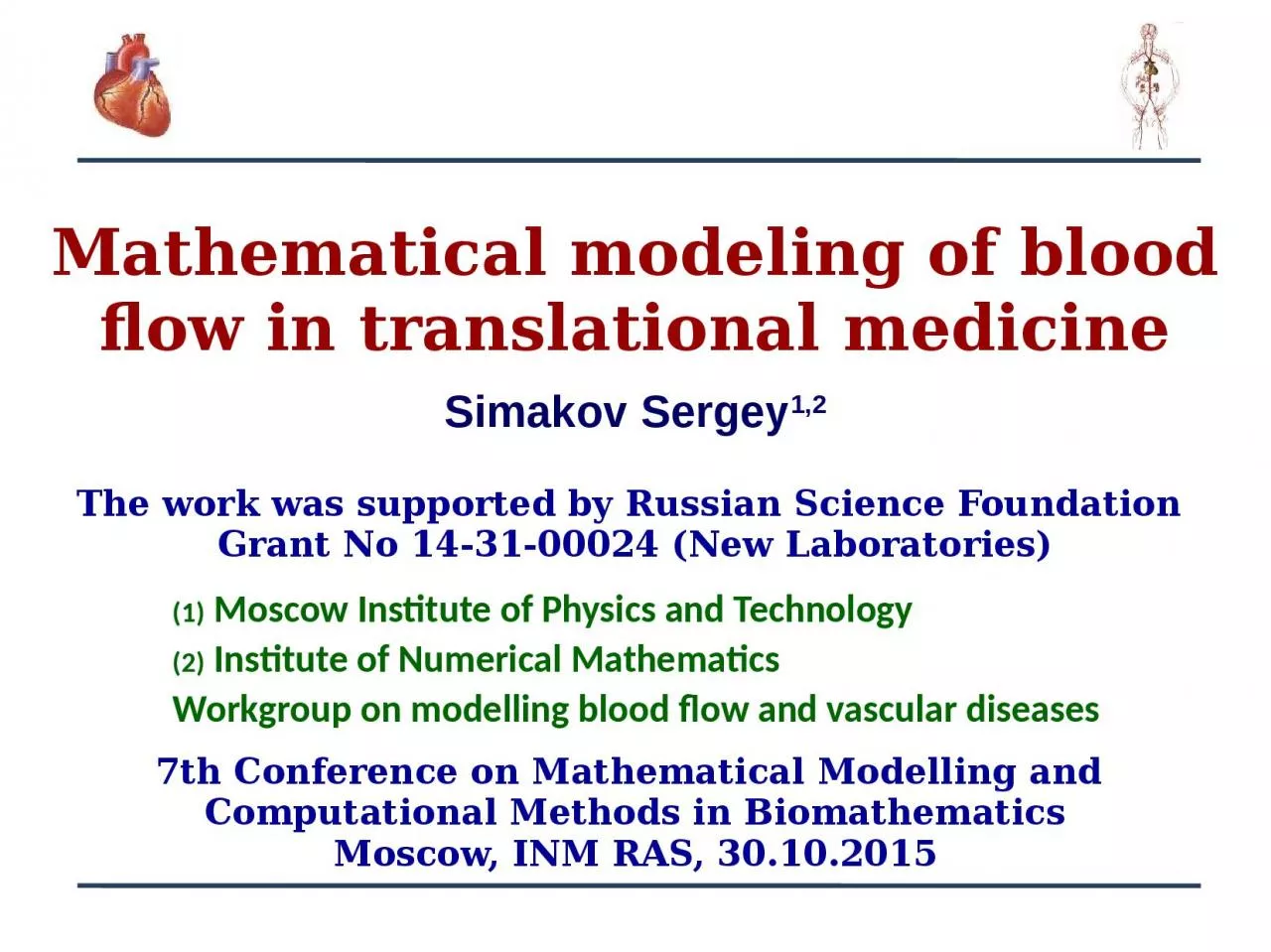

1 Moscow Institute of Physics and Technology 2 Institute of Numerical Mathematics Workgroup on modelling blood flow and vascular diseases Simakov S ergey 1 ID: 916951
Download Presentation The PPT/PDF document "Mathematical modeling of blood flow in t..." is the property of its rightful owner. Permission is granted to download and print the materials on this web site for personal, non-commercial use only, and to display it on your personal computer provided you do not modify the materials and that you retain all copyright notices contained in the materials. By downloading content from our website, you accept the terms of this agreement.
Slide1
Mathematical modeling of blood flow in translational medicine
(1) Moscow Institute of Physics and Technology(2) Institute of Numerical MathematicsWorkgroup on modelling blood flow and vascular diseases
Simakov Sergey1,2
7th Conference on Mathematical Modelling and Computational Methods in BiomathematicsMoscow, INM RAS, 30.10.2015
The work was supported by Russian Science Foundation
Grant
No 14-31-00024 (
New Laboratories)
Slide21D
Systemic
Blood Flow Model
Slide3Global blood flow
1) Mass balance
2)
Momentum balance
3)
J
unctions
3.1
3.2a
2a)
2b)
3.2b
3.2c
Slide4Vessel wall elasticity
Pedley, Luo, 1998
Modelling
Analytic approximation
Yu.
Vassilevski
, S Simakov, V.
Salamatova
, T.
Dobroserdova
, Blood
Flow Simulation in Atherosclerotic Vascular Network Using Fiber-Spring Representation of Diseased
Wall, Math. Mod. In Nat. Phenom., 6(5):333-349, 2011
Slide5Wall elasticity adaptation to average pressure
T
T
Physiological conditions:
autoregulation
Mechanism:
shear stress
NO production
endothelial layer permeability
Slide6Gravity and Autoregulation
S
S
Head
Leg
Auotregulation
Collapsible tube
Slide7Biomedical
Applications:
Angiosurgery
Enchanced External CounterpulsationFractional Flow ReserveCerebral Flow
Slide8Angiosurgery
(stenting)
Slide9Vascular surgery:
stenosis treatmentMRI/CTUltrasound dopplerography
Computational model:
1D vascular structureFunctional parameters fitting (elasticity, resistance)S
imulations
Slide10Stenosis treatment:
boundary
conditions and identification
Boundary conditionsInput (arteries):Output (veins):
Parameters identification
Ultrasound measurements (before surgery!)
Angles between vessels at bifurcations
Large vessels
–
rigid walls
,
small vessels
–
more elastic
Occlusion
– decreased lumen, high resistance
Slide11Stenosis treatment:
1D vascular domain reconstruction
Slide12Stenosis treatment
Patient-specific MRI and Doppler ultrasound data thanks to
I.M. Sechenov First Moscow State Medical University (Ph.Kopylov, et.al.)
S.Simakov, T.Gamilov, Yu.Vassilevskii, Yu.Ivanov, P.Kopylov, Patient specific haemodynamics modeling after occlusion treatment in leg, Mat. Mod. Nat. Phen, 2014
Slide13Enhanced External
Counterpulsation
(EECP)
Slide14EECP review
Ischemia Arterial Hypertension Cardiovascular
insufficiency
Indications
Risk factors
Aneurisms rupture
Atherosclerotic
p
laques rupture
Varicos
e veins
Individual EECP strategy is required!!!
Slide15A
B
C
EECP model
Wall state equation
Cardiac cycle
0
1
systole
diastole
Slide16Patient-specific EECP treatment simulations
Slide17EECP optimization:
sensitivity analysisImpact of myocardial pressure
Impact of arterial stiffness
Impact of autoregulation response rateT.Gamilov, S.Simakov, Modelling of coronary flow stimulation by enchanced external counterpulsation, Int. J. Num. Met. Biomed. Eng (under review)
Slide18Virtual Fractional Flow Reserve
Assesment
Slide19Fractional Flow Reserve
Review endovascular intervention expensive transducer
Solution: Virtual FFR assessment basing on
non-invasively collected data (CT scans, systolic/diastolic pressure, heart rate …)Clinical measurements requireF.Yu.
Kopylov
, A.A.
Bykova
, Yu. V.
Vassilevskii
, S.S. Simakov, Role
of measurement of fractional flow reserve in coronary artery
atherosclerosis,
Terapevticheskii
Arkhiv
,
87(9):106-113, 2015
Slide20Fractional Flow Reserve
1D vascular domain reconstruction
Slide21Fractional Flow Reserve
T.Gamilov, Ph. Kopylov, R. Pryamonosov, S.Simakov, Virtual fractional flow reserve assessment in patient-specific coronary networks by 1D haemodynamic model, Russ. J. Num. Anal. Math. Mod., 2015
Slide22Cerebral Flow:
Carotid Stenosis Treatment
Slide23Cerebral Flow
1D vascular domain reconstruction
Patient A
Patient B
Slide24Cerebral Flow
LeftRight
model (cm/s)
measured (cm/s)error (%)model (cm/s)
measured (cm/s)
error (%)
Patient A
Common Carotid Art. (No 26, 3)
50
55
9
51
54
5,5
Internal Carotid Art. (No 27, 86)
72
67
7
240
220
10
Patient B
Common Carotid Art. (No 13, 36)
51
58
12
60
56
7
Internal Carotid Art. (No 19, 28)
130
96
35
58
55
5
Before treatment (with stenosis)
Slide25Cerebral Flow
After treatment (stenting)
Vessel's indexVelocity, cm/s
Patient A
Patient B
Patient A
Patient B
Norm
Common Carotid Art.
3, 26
2, 13
60
59
50-104
Internal Carotid Art.
27, 86
19, 28
48
60
32-100
External Carotid Art.
74-75, 12-13
29-31, 14-16
60
90
37-105
Vertebral Art.
42, 55
5, 10
50
35
20-61
Subcluvian Art.
54-52-50, 56-60-64
40, 3-4, 41-43-46
98
95
60-150
Slide26Conclusions
Adequate tool for local and systemic blood flow analysis is developed
Successful patient-specific simulations cover
Femoral artery stentingEECP impact to the blood flow Virtual FFR assessmentCarotid artery stentingFull automatization of the presented algorithm and validation with more clinical cases are required to translate this research to the bedside
Slide27Thank You!